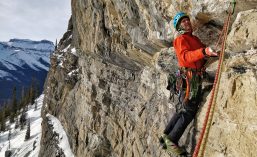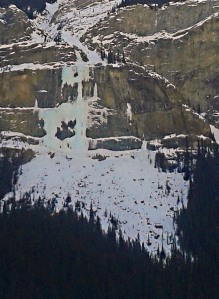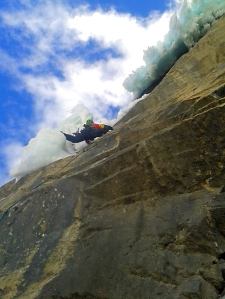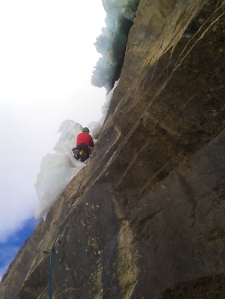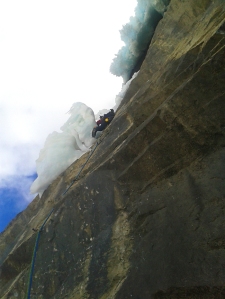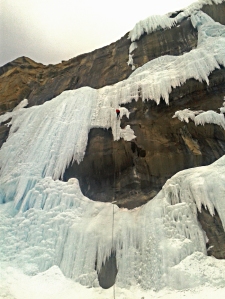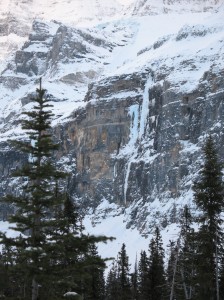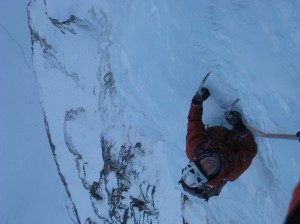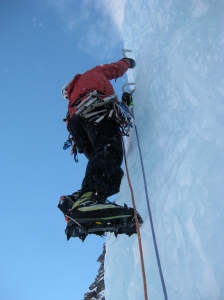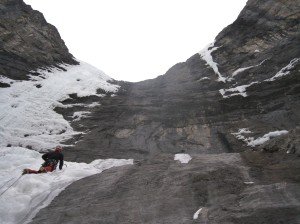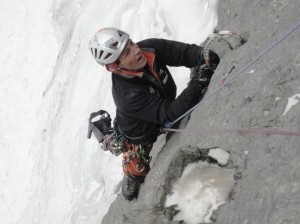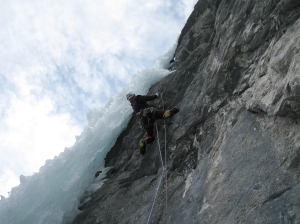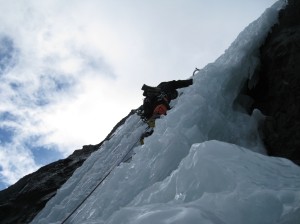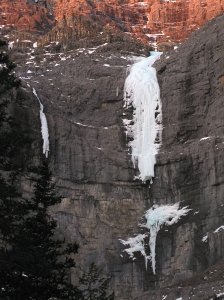
Approaching The 200 meter high Big Drip in the early morning hours of March 4, 2010.
March 4, 2010. The temperatures are in the forties today here in Canmore, Alberta. I am feeling relieved that I no longer have to think about whether there will be a catastrophic collapse of an ice formation on the Ghost’s classic mixed route, the Big Drip V M7+ WI6. Yesterday was my second go on the climb. Fortunately, Spanish climber Tato Esquirol de Arteaga and I managed to climb the route without being demolished. I’ll qualify that statement using my generous definition of “climb”: I rested where I needed to on the first pitch.
What a spectacular setting! Tucked in a huge cirque, I appreciated the majestic expanse of the Ghost River Valley to the east. The fact that enough water trickles down on these walls to the degree that it creates these outstanding formations of ice seems a true gift of nature. The Ghost is a pretty dry place, in general.
When I first went to the Drip a few weeks back with Erik Schnack we rapped off from the top of the second pitch. Since then, Eric returned to finish the route. He raved about the possibility of climbing directly out the horizontal ice ceiling which hangs precariously over the belay after the third pitch. With about a million tons of ice perched over my head yesterday, I was just glad Thursday didn’t become the day something gave way. Without remorse, we went the “traditional” way on lead four; through a keyhole (the slot formed between a chunky pillar of ice hanging down from the ceiling that has somehow not fallen off yet and the rock wall), and on up a “chimney” behind the pillar. Even in the drained state I was in after the two stiff mixed pitches below us, the “chimney” felt like 5.6 climbing. I could use great foot holds in the ice and simply lean back onto the rock wall when my forearms complained.
This lead, which eventually traverses around to the front of the huge main pillar, was worth doing simply for the buzz of experiencing such an exhilarating atmosphere. When I first contemplated the moves around the pillar to reach the front side of it, I realized how sketchy that maneuver appeared to me. I quivered while imagining the quality of the ice on the edge of the pillar and how scary it would feel to pull around it. But by the time I got there, the bad ice, if there was any, had been knocked off by previous parties this winter. It was truly an exhilarating and exceedingly memorable pitch!
The warm temperatures were not going to let us off easily, however. Though the ice was plastic and we were warm all day, there was one spontaneous release of rock from far above the route which came down directly over the wide belay ledge two pitches from the top. While clipped to the two bolt belay anchor on the ledge out right of the pillar, I had absolutely no place to hide. It felt like the worst of all positions when the rockfall occured. It was very chilling. Arriving with perhaps a 7 second warning rumble, I looked up to see about 50 stones sailing off the top lip of the cliff directly above me. Some were quite large (basketball size?) boulders. But most were smaller baseball to golf ball size stones. There were so many that I didn’t even look up to see where they were going to hit. I just lowered my head slightly and made myself as small a target as possible. Tato was just above the break over of the “chimney’ pillar pitch on easy ground, about 10 meters below my belay. He couldn’t get out of the way either. It was terrible timing, considering our exposure to the falling stones. Three or four seconds later, the ledge was pounded. I don’t know why, but we were spared from being pummeled by the projectiles. Needless to say, we sprinted through the last two ice leads and hastily rappelled off! It felt pretty good to get off the climb in one piece.
Looking back on the route, it is a fine series of exciting pitches. As a whole, I believe it compares with Cryophobia and Nightmare on Wolf Street as an outstanding ice and mixed route in a superb setting.
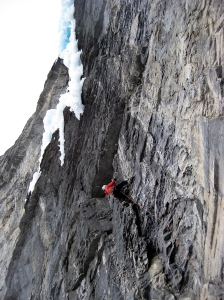
Carlos approaching the overhang on the first pitch.

Carlos reaching the slender and delicate icicle after the steep rock of the first pitch
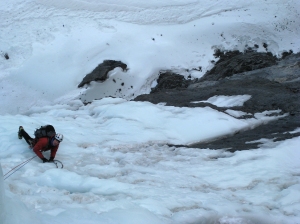
The second pitch consisted of numerous ice mushrooms and a loose, poorly protected mixed section to reach a large ledge.

Tato leading the strenuous overhang on the third pitch.

Carlos approaching the slot leading behind the huge pillar on pitch 4.
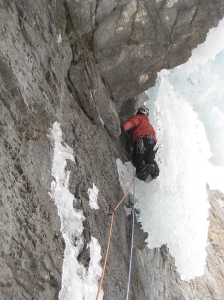
Carlos inside the ice slot and beginning the chimney on pitch 4.
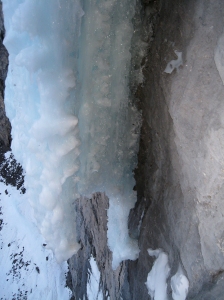
Looking into the chimney of pitch 4 from our rappel off the route. The ice slot is visible at the bottom.
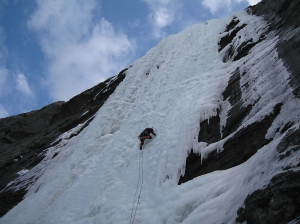
Tato leading the second to last pitch up the final curtain of ice.

